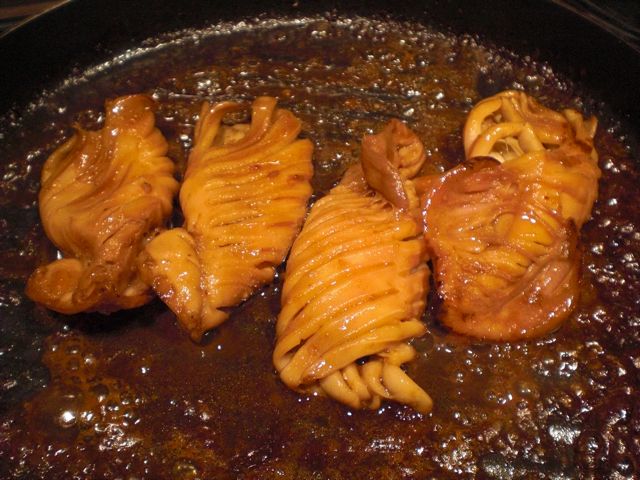In contrast, where we now live, most squid is of either the previously or "presently" frozen pre-cleaned variety. To my pleasant surprise, however, I found fresh squid (uncleaned) at one of our regular grocery stores. Naturally, I had to get some. Although the freshness was nothing close to those available in Japan (many are still alive), this is much better than frozen ones. Although the exact variety is unknown to me, it was larger than most frozen squid.
I pondered what to make from this squid but decided to make it in a classic Izakaya or street food way; grilled squid with ginger soy sauce. Otsumami yokocho おつまみ横町 page 74 has a similar recipe but this type of squid dish is rather classic. I remember this type of squid (served on a stick, see image on the left) was one of my favorite food stand foods during Japanese festival days* or "en-nichi" 縁日 when I was a kid. (Image from http://wallpaper.free-photograph.net/jp/photobase/yp5821.html).
*The closest equivalent I can think of in the U.S. would be a county or state fair.

Just in case you have never cleaned squid: You first have to remove the innards by gently pulling the tentacles while holding the body. If you pull it correctly, all the innards come out in one piece. Then remove the cartilage which runs the entire length of the body of the squid. My squid must have had a hard life. The cartilage was broken in the middle in almost all of them. In that case, you have to go back with you finger into the body cavity of the squid and get the remaining cartilage out. As for the tentacles, I cut into them just beneath the eyes and go under the "beak" to cut them from the eyes and innards. If the beak was still attached to the tentacles, make sure you remove it. I then cut the tentacles at the base into two parts. I removed the skin from the body tube, although you do not have to do it. I did not remove the "fin" at the top of the body called "enpera" エンペラ. I scored the tube in an oblique fashion on both sides to make it easier to eat.
I first marinated the prepared squid in a mixture of sake and soy sauce (1:1) and grated ginger root (1/2 tbs) for several hours in the refrigerator. Since I could not have a charcoal fire to grill the squid, I sauteed it instead. After I removed the squid from the marinade, I carefully dried them with paper towels despite this liquid came out from the squid while cooking and prevented it from nicely browning. This was unavoidable since I did not grill on a charcoal fire. After a few minutes turning once I added a small amount of the marinade and reduced the heat for 2-3 minutes and made a sauce to coat the surface of the squid (see below). If I was grilling I would have brushed on the marinade towards the end of the grilling.

This was not one of my best efforts but the squid was very tender and soy sauce ginger flavor was perfect. For a good measure, I also added a small dab of freshly grated ginger root. We had this with cold sake.
I first marinated the prepared squid in a mixture of sake and soy sauce (1:1) and grated ginger root (1/2 tbs) for several hours in the refrigerator. Since I could not have a charcoal fire to grill the squid, I sauteed it instead. After I removed the squid from the marinade, I carefully dried them with paper towels despite this liquid came out from the squid while cooking and prevented it from nicely browning. This was unavoidable since I did not grill on a charcoal fire. After a few minutes turning once I added a small amount of the marinade and reduced the heat for 2-3 minutes and made a sauce to coat the surface of the squid (see below). If I was grilling I would have brushed on the marinade towards the end of the grilling.


No comments:
Post a Comment
When you post a comment on the post, it does not appear immediately pending moderation.